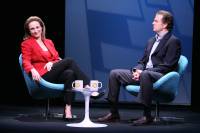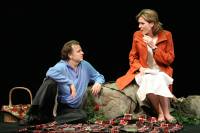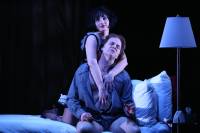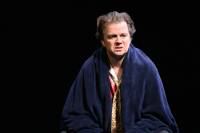
An embittered pink-slipped employee enters his former workplace and, automatic weapon in hand, murders thirty-seven of his ex-coworkers yet spares number thirty-eight, leaving the massacre’s sole survivor to wonder why. Why was he alone shown mercy? To whom does he owe this inexplicable stroke of salvation?
These are the questions John Smith (Kevin Anderson) asks himself in Neil LaBute’s gripping The Break Of Noon, now in its co-World Premiere at Westwood’s Geffen Playhouse following a New York debut this past fall. The Los Angeles portion of its two-pronged World Premiere reunites director Jo Bonney, the East Coast design team, and half of the off-Broadway cast for an absolutely riveting, superbly acted ninety-minutes of drama, suspense, surprises, and an unexpected number of laughs.
Anderson assumes the role played in New York by David Duchovny, and if his name is less quickly recognizable than The X Files and Californication’s Duchovny, the man who rescued Julia Roberts from her maniacal husband in Sleeping With The Enemy more than makes up for it with a stage résumé that includes decades of roles with Chicago’s Steppenwolf. (In contrast, Duchovny was making his stage debut as Smith.) Anderson’s live theater background is but one reason that L.A. theater audiences can consider themselves fortunate. Unlike his New York counterpart, whose screen persona can border on creepy, Anderson comes across a more likeable Everyman (think Jeff Bridges or Dennis Quaid), making his casting as John Smith particularly inspired.
Smith is, you see, not a particularly likeable chap. Those who saw the New York production used adjectives like bullying, exploitive, manipulative, mean, philanderering, racist, and violent to describe him. And though John tells us that he is “still just the same man” as ever, he is now one with a mission in life—to spread God’s word. After all, it’s not every day the Man Upstairs speaks to one of us in his “beautiful deep clear voice” and tells us in time of grave danger, “Stay here, and you shall be saved.”
We first meet John as he delivers The Break Of Noon’s opening monolog, one of two very different ones which bookend the play’s six two-character scenes. His foot still bandaged from a slight bullet wound and his clothes still bloodied, the massacre’s sole survivor describes to us the horror he managed to escape from, and the message he received from God, to spread the word that “we should try to be good.”
As John meets with a) an opportunistic lawyer, b) his still bitter ex-wife, c) a slick talk show host, d) his ex-wife’s cousin (and one of the women he cheated on her with), e) the hooker daughter of one of the office victims, and f) a police detective investigating the case, we not only discover many facets of John’s personality and character, we also learn increasingly specific details of the massacre and of John’s conversion, leading us to wonder how much of what John is saying is true, and how much is embellished or even invented on the spur of the moment? With Anderson playing John, however, we find ourselves considerably more torn between belief and skepticism than New Yorkers must have felt with a less innately trustworthy Duchovny in the role.
Despite considerable post-performance discussion with friends, this reviewer remains unsure of LaBute’s purpose in writing The Break Of Noon, or of what lesson (if any) he wishes us to take from John Smith’s life change. Regardless, the story being told is one to keep audiences on the edge of their seats, particularly in a production acted, directed, and designed as dazzlingly as this one is.
Anderson is onstage for the full ninety minutes of The Break Of Noon’s running time, and his commanding performance can only be described as tour de force. It’s also a lesson for acting students in the subtle and not so subtle changes that take place in each of us depending on the person we’re interacting with and the situation we find ourselves in. The John Smith we see with ex-wife Ginger is not the same man we see with ex-lover Jesse (both women played by a terrific Catherine Dent, new to the L.A. production) nor does he act or react the same with the lawyer he consults as with the police detective who interrogates him (John Earl Jelks, dynamic in both roles). As for the John Smith who is interviewed by the TV Host From Hell and the one who has hired “French maid” hooker Gigi (who turns out to be a very different real-life Jill), Anderson’s work—and that of the extraordinary Tracee Chimo in both (all three?) roles—deserves to be seen and savored.
The bicoastal work of the New York/L.A. design team is likewise outstanding. Scenic designer Neil Patel has created a striking revolving set which situates each scene in front of a stark black-and-white backdrop and surrounds the proscenium with a row of lights which ignite suddenly and blindingly between scenes, courtesy of lighting designer David Weiner, the entire mix punctuated by Darron I. West’s stunning sound design. ESosa’s costumes, Justin Ellington’s original music, Matthew Holtzclaw’s special effects, and J. Jared Janas and Rob Greene’s character-defining wigs are equally deserving of kudos.
Stephen Gabis and Paul Wager are dialect coaches, Bo Foxworth fight choreographer, Christina Lowe production stage manager, and Jennifer Brienen assistant stage manager.
Some have criticized LaBute’s latest as “underthought” or “problematic,” and while it is indeed true that one leaves the theater wondering what it was all about, this is one case where individual scenes (each virtually its own short one-act) and performances are so powerful as to make negative adjectives like the above come across as nitpicking. I may not be able to tell you what John Smith’s story means, but seeing and hearing it told so thrillingly not only makes for a rewarding evening of theater, but provides endless food for conversation and thought—and how many plays can you say that about?
Geffen Playhouse, 10886 Le Conte Ave., Westwood.
www.geffenplayhouse.com–Steven Stanley
February 3, 2011
Photos: Michael Lamont






 Since 2007, Steven Stanley's StageSceneLA.com has spotlighted the best in Southern California theater via reviews, interviews, and its annual StageSceneLA Scenies.
Since 2007, Steven Stanley's StageSceneLA.com has spotlighted the best in Southern California theater via reviews, interviews, and its annual StageSceneLA Scenies.







 COPYRIGHT 2024 STEVEN STANLEY :: DESIGN BY
COPYRIGHT 2024 STEVEN STANLEY :: DESIGN BY